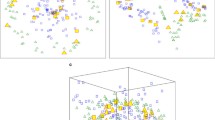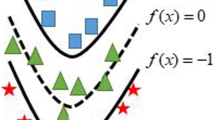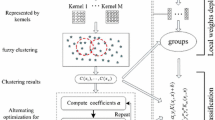Abstract
This paper proposes a soft clustering algorithm based on a fuzzy one-class kernel-free quadratic surface support vector machine model. One main advantage of our new model is that it directly uses a quadratic function for clustering instead of the kernel function. Thus, we can avoid the difficult task of finding a proper kernel function and corresponding parameters. Besides, for handling data sets with a large amount of outliers and noise, we introduce the Fisher discriminant analysis to consider minimizing the within-class scatter. Our experimental results on some artificial and real-world data sets demonstrate that the proposed algorithm outperforms Bicego’s benchmark algorithm in terms of the clustering accuracy and efficiency. Moreover, this proposed algorithm is also shown to be very competitive with several state-of-the-art clustering methods.

Similar content being viewed by others
References
An W, Liang M (2013) Fuzzy support vector machine based on within-class scatter for classification problems with outliers or noises. Neurocomputing 110:101–110
Bache K, Lichman M (2013) UCI machine learning repository. http://archive.ics.uci.edu/ml
Bai Y, Han X, Chen T, Yu H (2015) Quadratic kernel-free least squares support vector machine for target diseases classification. J Comb Optim 30:850–870
Baudat G, Anouar F (2000) Generalized discriminant analysis using a kernel approach. Neural Comput 12:2385–2404
Bicego M, Figueiredo M (2009) Soft clustering using weighted one-class support vector machines. Pattern Recogn 42:27–32
Camastra F, Verri A (2005) A novel kernel method for clustering. IEEE Trans Pattern Anal 27:801–805
Cortes C, Vapnik V (1995) Support-vector networks. Mach Learn 20:273–297
Dagher I (2008) Quadratic kernel-free non-linear support vector machine. J Glob Optim 41:15–30
Figueiredo M, Jain A (2002) Unsupervised learning of finite mixture models. IEEE Trans Pattern Anal 24:381–396
Fisher R (1936) The use of multiple measurements in taxonomic problems. Ann Hum Genet 7:179–188
Fukunaga K (1990) Introduction to statistical pattern recognition. Academic, San Diego
Jain A, Dubes R (1988) Algorithms for clustering data. Prentice-Hall, Englewood Cliffs
Kohonen T (1982) Self-organized formation of topologically correct feature maps. Biol Cybern 43:59–69
Krawczyk B, Wozniak M (2015) One-class classifiers with incremental learning and forgetting for data streams with concept drift. Soft Comput 19:3387–3400
Krawczyk B, Wozniak M, Cyganek B (2014) Clustering-based ensembles for one-class classification. Inf Sci 264:182–195
Lin C, Wang S (2002) Fuzzy support vector machines. IEEE Trans Neural Netw 13:464–471
Livi L, Sadeghian A, Pedrycz W (2015) Entropic one-class classifiers. IEEE Trans Neural Netw 26:3187–3200
Luo J, Fang S-C, Deng Z, Guo X (2016a) Quadratic surface support vector machine for binary classification. Asia Pac J Oper Res 33:1650046. doi:10.1142/S0217595916500469
Luo J, Fang S-C, Bai Y, Deng Z (2016b) Fuzzy quadratic surface support vector machine based on Fisher discriminant analysis. J Ind Manag Optim 12:357–373
Martinetz T, Schulten K (1993) Neural-gas network for vector quantization and its application to time-series prediction. IEEE Trans Neural Netw 4:558–569
Ng A, Jordan M, Weiss Y (2001) On spectral clustering: analysis and an algorithm. Adv Neural Inf Process Syst 2:558–569
Sartakhti JS, Afrabandpey H, Saraee M (2016) Simulated annealing least squares twin support vector machine (SA-LSTSVM) for pattern classification. Soft Comput. doi:10.1007/s00500-016-2067-4
Schölkopf B, Smola A (2002) Learning with kernels: support vector machines, regularization, optimization, and beyond. MIT Press, Cambridge
Shawe-Taylor J, Cristianini N (2004) Kernel methods for pattern analysis. University Press, Cambridge
Tax D, Duin R (1999) On spectral clustering: analysis and an algorithm. IEEE Trans Neural Netw 20:1191–1199
Tay F, Cao I (2001) Application of support vector machines in financial time series forecasting. Omega 29:309–317
Yang J, Deng J, Li S, Hao Y (2015) Improved traffic detection with support vector machine based on restricted Boltzmann machine. Soft Comput. doi:10.1007/s00500-015-1994-9
Zhou L, Lai K, Yen J (2009) Credit scoring models with AUC maximization based on weighted SVM. Int J Inf Technol Decis Making 4:677–696
Acknowledgements
Tian’s research has been supported by the Chinese National Science Foundation #11401485 and #71331004.
Author information
Authors and Affiliations
Corresponding author
Ethics declarations
Conflict of interest
The authors declare that they have no conflict of interest.
Additional information
Communicated by V. Loia.
Rights and permissions
About this article
Cite this article
Luo, J., Tian, Y. & Yan, X. Clustering via fuzzy one-class quadratic surface support vector machine. Soft Comput 21, 5859–5865 (2017). https://doi.org/10.1007/s00500-016-2462-x
Published:
Issue Date:
DOI: https://doi.org/10.1007/s00500-016-2462-x




